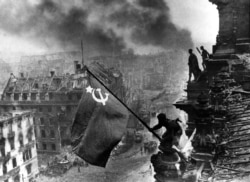On June 24, 1948, Soviet leader Josef Stalin blocked all road, rail, and water routes through communist East Germany into the western portion of the divided city.
His aim -- to conquer what was an enclave inside the Soviet-controlled east. It was the culmination of tensions between the Soviet Union and the Western powers that shared in Germany's postwar occupation.
But then on June 26, the first planes carrying much-needed supplies began flying in from West Germany. It was the beginning of the Berlin airlift -- the biggest humanitarian operation of its kind.
"Berlin was in rubble and was not very pleasant at that time after the war," recalls Traute Grier, who was going on 16 at the time of the blockade. "Everything was rough for people, we had to hunt for food, people had to hunt for housing, there was no heating system, we had not much electricity, so it was a horrible time.
"The Russians were trying to starve us out, their dictatorship was awful and for us they weren't very human, so the Western allies were trying to help us and we appreciated it so much. [The airlift] was like heaven came down on us. We had very little food from them, because everything was rationed, but still the little we got, it was hope, and that made us look up to the Western allies, and [we] had enough later on to eat."
Grier says that U.S. pilot Gail Halvorsen "was a very sweet pilot and later others helped him. He dropped candies to the children, [who] came in the hundreds towards the airports trying to catch some candy, it was constant fighting among the children who could catch a piece. Myself, I didn't have a sweet tooth, I wasn't out for the candy, and I never would have got some because so many of the kids were fighting.
"But that was something to look [forward] to. First we were bombed and now we got all the good stuff from them, people looked up to the Americans, to the British people, also to the French [because] they supplied us with all the goodies. It was just something amazing and we appreciate that so much and still have to say 'thank you' today and not to forget what they had one time done [for] us. And those children who are grown-ups now who received a candy bar -- they should say a dozen times 'thank you' each night that we were saved from starving to death."
Over the next year, U.S. and British planes made nearly 300,000 flights, delivering more than 2 million tons of food, fuel, and other supplies in order to keep over 2 million people alive.
"As we got into the winter over there we had many, many foggy days, and it was fog from ground level up to higher than we went, we were flying on instruments a lot of the time," says Donald Luehmann, who was 23 at the time of the airlift and a sergeant in the U.S. Army Air Corps. "I was actually stationed in the British Zone, up in Celle. We started out in Frankfurt, but they transferred us up to Celle because it was a shorter trip."
Luehmann says that the air corridor that the U.S. and British planes used was "a strip about a mile wide that we could fly in from Celle to Berlin. And we had to stay in that one-mile corridor. The Soviets threatened to take drastic action if we wandered out of the corridor. [You] had to really watch the instruments, but the pilots were all good, they were quite experienced."
"At that time I didn't think much about it, it was part of our job. We were supposed to be flying -- as our unit designation would show -- we were an air-transport squadron," Luehmann adds. "I was stationed permanently out in California, and we flew from California to Australia and Thailand, [and] all the islands out in the Pacific. We were just a transport squadron flying military supplies. So it just happened we were flying different kinds of supplies out to Berlin."
In May 1949, the Soviet blockade was lifted -- though the allies' flights continued for several more months. This week. people in Germany and beyond are commemorating what became a symbol of Western resolve against the Soviet threat.
"You have to appreciate and not to forget what they did -- to help 2 million people from starvation," Grier says. "What they had to do -- the organizing, all the logistics with those planes, every two minutes came a plane, and those pilots never had a rest, and so many are dead. Seventy people died on that mission to bring us food. We owe them so much."
More Than Propaganda

Soviet photographer Yevgeny Khaldei, who was born in 1917 and died in 1997, was one of the Soviet Union's best-known photographers of the Great Patriotic War, documenting Soviet advances Belgrade, Budapest, Vienna, and Berlin. More than a half-century later, Khaldei's images -- some of which were staged -- remain a subject of fascination and controversy.












